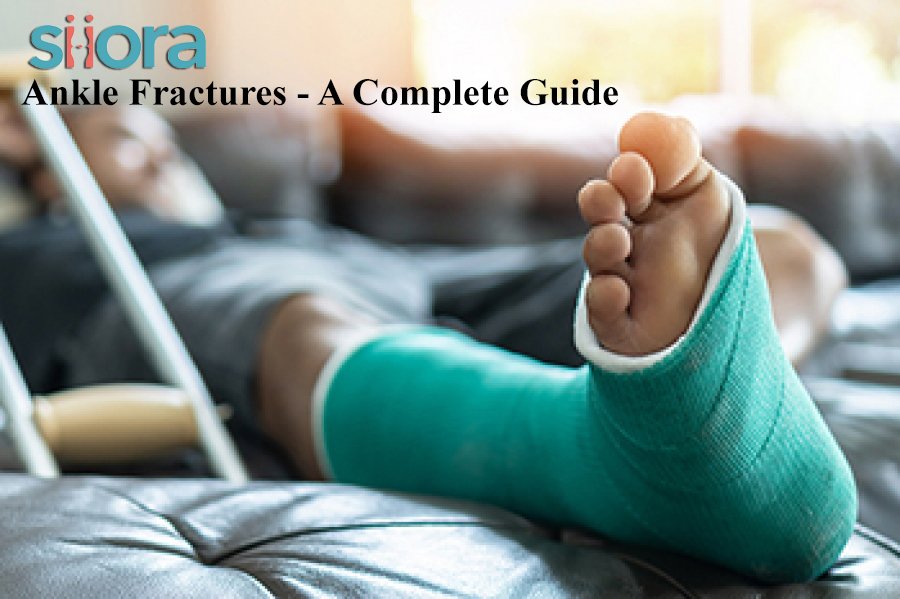The ankle joint is a type of hinged synovial joint formed by three bones namely the tibia, fibula, and talus. During ambulation, the ankle joint plays a critical role as it adapts to the nature of the surface on which a person walks. Any injury to the ankle would make it difficult for the affected person to walk properly. In most cases with a severe ankle injury, putting even a small amount of weight would be impossible. Here we will talk about ankle fractures.
Fractures are the most commonly reported injuries in the ankle, and sometimes, they could be severe enough to require complete bed rest for a week or two. Ankle performs multiple movements, and they include plantar flexion, dorsiflexion, inversion, and eversion. All these movements help perform different activities like walking, running, playing sports, doing exercise, and many more.
If your ankle gets fractured, the range of motion will become limited along with intense pain and other associated symptoms. Here, we are going to talk about ankle fractures in detail along with their diagnosis and treatment.
What Happens When an Ankle Breaks?
A broken ankle is a condition where a fracture or multiple fractures are seen in any of the three bones that form the ankle joint. These types of injuries are known to be the commonest bone and joint injuries and are characterized by pain, inability to walk, swelling, and other symptoms.
The ankle joint is stabilized by several ligaments that hold all the bones in place. Sometimes, ligament injuries could also cause issues in the ankle, and the symptoms may be similar to that of ankle fractures.
Ankle fractures are listed among common childhood injuries as children are more prone to breaking their ankles while playing or doing other activities. In children, ankle fractures may also involve the growth plates that are located near the end of long bones. Depending upon the age of the child, different types of ankle fractures are there, and they may vary from mild to complex. The treatment will also be based on the type of fracture that has occurred.
What Causes Ankle Fractures?
Children are more active than adults, and it is important for their growth. Considering this, we must say that the physical activity level in kids is also higher, and that’s where the fractures come into the picture. The most common cause of the condition includes sudden twisting of the ankle while walking, running, or playing any sports.
Children keep jumping and running here & there without knowing that an injury could be on the cards. This is another reason why such fractures are the common childhood injuries. Kids who participate in athletics and other sports activities are at high risk of breaking their ankles. Sometimes, a child might land on its opponent’s foot while playing, and this may break the ankle of the opponent.
Ankle fractures not only occur in kids, but they also affect adults. Besides this, the cause may be different. Automobile accidents like car or bike crashes are common causes of ankle fractures in adults. Besides this, a wrong step on a bumpy bad road could also result in a broken ankle. People who engage in sports like basketball, soccer, or football are also prone to ankle fractures. This could be because of bad landing after a jump could put them in trouble.
Elderlies are also prone to fractures in their ankle, and in them, a slight fall or misstep could be the reason. Osteoporosis is one of the conditions that is commonly seen in people above 50, and the condition is characterized by loss of bone mineral density. Osteoporosis makes bones porous, and they can break anytime. Thus, aged people suffering from the condition could experience broken ankles even when they step down from their bed in the morning or while walking.
Above all, people who smoke (irrespective of age) could also get fractures anywhere their body including the ankle. Smoking reduces bone mineral density and increases the chances of osteoporosis. Even healing of fracture takes a longer time in people who smoke.
What Are the Types of Ankle Fractures?
The ankle could break at different locations, and this depends upon its cause and severity. Some of the common types of ankle fractures reported include:
Lateral Malleolus Fracture
This type of ankle fracture is the commonest, and it occurs on the bony prominence that is there on the outside part of the ankle that is formed by the lower end of the fibula.
Medial Malleolus Fracture
Another location where fractures occur in the ankle is the medial malleolus, the bony bump present on the inner side of the ankle. The lower end of tibia forms medial malleolus.
Bimalleolar Ankle Fracture
This is the second most common type of ankle fracture. In such cases, both lateral and medial malleolus break.
Trimalleolar Ankle Fracture
This is a more severe form than bimalleolar fractures as it involves breaking the ankle at three locations. The affected sites include:
- Medial malleolus
- Lateral malleolus
- The lower part of the posterior malleolus of the tibia
Plafond Fracture
This is the type of ankle fracture that occurs at the bottom of the shinbone. Such conditions often involve the weight-bearing portion of the ankle joint, and they generally occur due to high-energy traumatic injuries. Their common cause includes rotational and axial forces that occur due to a fall from a height or car accident.
How to Prevent Ankle Fractures?
Prevention is always better than cure but sometimes, even prevention does not work. That doesn’t mean to stop paying attention to simple things as prevention can significantly minimize the risk of injuries. Let us see some simple preventive measures for ankle fractures:
Wear Right Fit Shoes
Shoes are always critical in preventing ankle injuries. Firstly, wearing perfect shoes is important as ill-fitted shoes will trouble you without any reason. Secondly, it is also necessary to wear shoes according to the purpose. For example, if you are going on a trek, then trekking shoes must be your feet. This is because normal running shoes might put unnecessary stress on your feet while increasing the chances of ankle injuries.
Regularly Replace Athletic Shoes
Now, this is important, athletes must replace their shoes when the heel wears out or the shoe balance becomes uneven. If they keep training with such shoes, they’ll be at high risk of experiencing ankle fractures or other foot injuries.
Build Bone Strength
Consumption of calcium-rich foods like dairy products is important to build bone strength and ensure the availability of optimum calcium levels in the body. Besides this, vitamin D intake is also important for the proper absorption of calcium. Here, consulting with a specialist about whether you should take supplements or not will be a great idea.
Improve Muscle Strength
Strengthening muscles is the key to reducing the risk of ankle fractures especially in people who are at high risk of twisting their ankle like sportspeople.
What is the Diagnosis of Ankle Fractures?
Right diagnosis of fractures is always critical for choosing the right treatment procedure, and hence, it is important to properly ankle fracture. This is because in some cases, the symptoms seen are of a fracture but, the cause is different.
The diagnosis of the condition often starts with the physical examination where the healthcare service provider looks for the deformity around the ankle along with other symptoms like swelling and bruising. Here, the patient will move his/her ankle in different directions to identify painful movements. This will give the surgeon an idea of whether the symptoms indicate a fracture or any other condition.
The confirmation can only be provided by imaging tests and x-rays are always the prime choice. X-rays are best at showing bone breaks at different angles. Sometimes, x-rays cannot provide any solid images, and in such cases, other radiological tests like MRI or CT-scan will help. They can identify the problems occurring at muscle or soft-tissue levels. The healthcare service provider may also order MRI or CT scan to identify stress fractures. Only after proper diagnosis, the healthcare provider can confirm the feasible treatment option for ankle fractures.
What is the Treatment for Ankle Fractures?
The treatment of the condition depends upon the alignment of the bone(s) and the number of breaks after the fracture, and diagnosis has made that clear. The treatment aims at healing the bones in their correct anatomy as much as possible. This is because if bones heal where they should not, malunion will occur and arthritis will be on the cards.
Thus, the first step during the treatment of ankle fracture will be to bring bone fragments to their correct alignment, and this process is reduction. Now, the reduction is of two types:
Closed Reduction
This is where the surgeon gives anesthesia and manually realigns the bones without making any incision. This procedure is best when multiple breaks are not there, and the displacement of the bone is not too far from its original position.
Open Reduction
Open reduction is a complex procedure, and it is performed when the break is severe or multiple broken bone fragments are detected during the diagnosis. During an open reduction, the surgeon makes an incision around the ankle to expose the damaged bone and realigns it using Orthopedic Implants like metal plates, pins, wires, and/or orthopedic screws. The surgeon will give anesthesia before the surgery.
Now, closed reduction is feasible when the fracture is not serious, and the surgeon often suggest it in young adults. After closed reduction, the surgeon applies a cast or a splint to immobilize the fracture and allow it to heal. Proper rest is important during the healing process as the condition could become worse.
When it comes to open reduction, it is performed in serious cases where reduction is not feasible without surgery. The whole surgical process is known as ORIF (Open Reduction and Internal Fixation). During surgery, the surgeon realigns broken bone fragments by applying trauma implants and instruments like orthopedic bone screws, pins, plates, & wires. After this, the surgeon will close the incision and share guidelines of what to do & what not to do with the patient and his/her guardian.
In some cases, the surgeon may also remove implants after healing.
The healing time depends upon the severity of the break, its location, and the age of the patient along with underlying health conditions. In healthy individuals, healing takes place within 6-8 weeks if the fracture is not too serious.
Siora Surgicals Pvt. Ltd. is a renowned and Indian-FDA-approved manufacturer of a huge range of orthopedic devices. The company produces all types of CE-certified implants that surgeons use for the treatment of ankle fractures and other orthopedic conditions. The implants are available in stainless steel and titanium. Some of the product range offered by Siora Surgicals include HELIX Locking Plate System, AURASPINE Implants & Instruments, ILIZARC Ring Ex-Fix System, and SCRUCAN Cannulated Compression System.
Siora is also one of the best OEM/contract manufacturing service providers around the globe.








